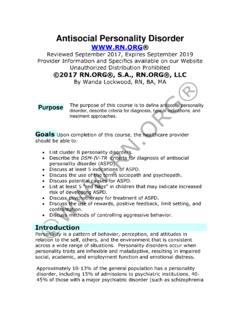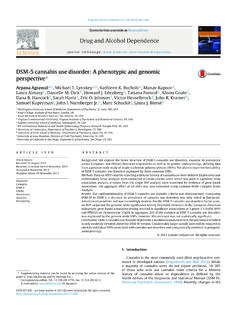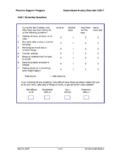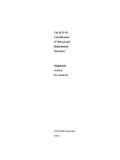Transcription of Bipolar Disorder - Unlimited Online Nursing CEUs for 19.99 ...
1 Bipolar Disorder Reviewed July, 2016, Expires July, 2018 Provider Information and Specifics available on our Website Unauthorized Distribution Prohibited 2016 , , , LLC By Wanda Lockwood, RN, BA, MA Purpose The purpose of this course is to define Bipolar Disorder , explain the symptoms, co-morbid conditions, causes, and treatment. Goal Upon completion of this course, one should be able to: Define Bipolar Disorder and describe the main classifications. Differentiate symptoms of manic and depressive episodes and list at least 4 symptoms for each both.
2 Explain diagnostic criteria for Bipolar Disorder . Discuss effects of Bipolar Disorder on children and adolescents. List at least 3 types of medications used for Bipolar Disorder . List at least 3 other types of treatments. Describe 3 types of potential causes of Bipolar disorders . Discuss environmental triggers. Describe at least 3 co-morbid conditions. Introduction Imagine what it s like to live with your brain on fast-forward. You can t sleep and can t slow your mind down to concentrate on anything.
3 You rush here and there, trying one thing and then another, sometimes filled with euphoria and other times irritation. You run up bills you can t pay and make promises you can t keep and lay waste to your life, and then you feel the world slowing down, crashing down, until you are moving through life in slow motion and can t do anything but lie in bed and cry, overwhelmed with feelings of hopelessness and helplessness. Sometimes you see frightening snakes or monsters or hear voices that terrify you. Sometimes, if you re lucky, you have periods when life seems normal, but then it starts speeding up again.
4 This is what untreated Bipolar Disorder is like. What is Bipolar Disorder ? Bipolar Disorder (formerly manic-depressive Disorder ) is a psychiatric affective (mood) Disorder characterized by mood swings between depression and mania. Bipolar Disorder affects about of adults over age 18 (6 million Americans annually). There are a number of different subtypes of Bipolar Disorder , and different researchers and sources utilize different classification systems, depending upon the episodes of depression and mania and the degree and frequency of symptoms.
5 The following are commonly identified subtypes: Bipolar I: This variant is characterized by at least one manic episode. In some cases, this is preceded by episodes of depression. This is a severe form of the disease, usually involving cycling between mania and depression with episodes of psychotic symptoms, such as hallucinations and paranoia. Bipolar II: This variant is characterized by at least one episode of depression and at least one episode of hypomania, which is similar to a manic episode but tends to be less severe and lasts only a few days.
6 Depressive periods last longer than hypomanic episodes. Cyclothymia ( Bipolar III): This is a milder form of Bipolar Disorder in which mood swings occur but are much less pronounced. Rapid-cycling: This form of Bipolar Disorder is characterized by rapid cycling between depressive and manic episodes, usually 4 in a 12-month period with mood changes occurring rapidly, sometimes within a few hours. Mixed state: This is characterized by both depression and mania occurring simultaneously. Regardless of how Bipolar is classified, it is essentially characterized by some degree of depression and mania, but the episodes may vary in duration and the intensity may vary from one individual to another.
7 What are the symptoms of Bipolar Disorder ? Symptoms of Bipolar disease typically manifest in late adolescence or early adulthood although increasingly Bipolar Disorder is diagnosed in children as well. Symptoms cover a continuum from one extreme to the other: Severe mania Hypomania Normal mood Mild to moderate depression Severe depression Because Bipolar Disorder is chronic, people experience symptoms of mania and depression throughout the course of their lives although they may have periods when they are free of symptoms.
8 About 33% of people have residual symptoms even between manic and depressive episodes, and some people have persistent symptoms that don t respond well to medications. The course of the disease tends to worsen over time with more rapid cycling if the person does not receive treatment. The criteria for diagnosis depend upon the type and number of symptoms. Symptoms are different depending upon whether the person is in the manic stage or depressive stage: Manic episode: If the person has an elevated mood, there must be at least 3 additional symptoms most of the day, nearly every day for 1 week.
9 However, if the mood is irritable, there must be at least 4 additional symptoms for 1 week. Symptoms include: o Markedly increased energy and restlessness o Euphoric mood and feeling of being high. o Extreme irritability o Thoughts racing, speech rapid, conversation jumping from one topic to another. o Difficulty concentrating and distracts easily. o Exhibits poor judgment. o Requires little sleep. o Feeling of being infallible in abilities and power. o Increased sexual drive. o Excessive spending without concern for expenses.
10 O Drug abuse, especially cocaine, alcohol, and sleeping medications. o Provocative, intrusive, pushy, aggressive behavior. o Behavior that is unusual and persists. o Denial that behavior, reactions, or feelings are abnormal. Depressive episode: The person must have 5 symptoms that persist most of the day, almost every day, for 2 weeks. o Persistent feeling of sadness, anxiety, or emptiness o Feeling of hopelessness or pessimism. o Intense feelings of guilt, lack of worth, and helplessness. o Marked decrease in energy and constant feeling of fatigue.
















